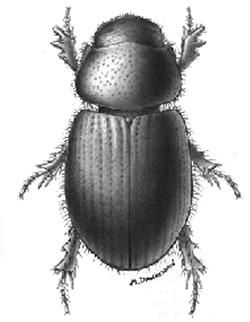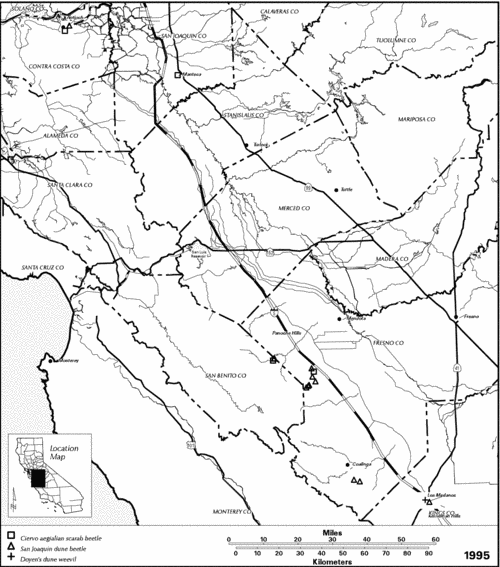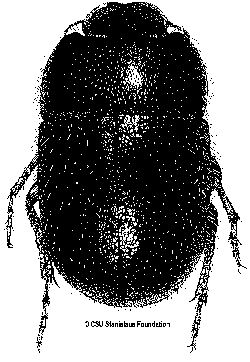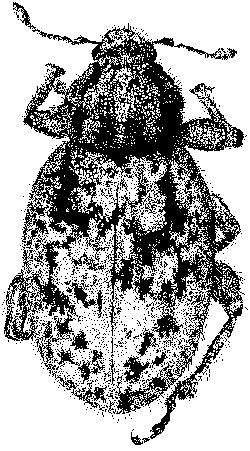Endangered Species Recovery Program | |
|
Home | News | Publications | Species profiles | Data and maps | About | Staff | Links | Department of Biological Sciences | CSU Stanislaus |
Recovery Plan for Upland Species of the San Joaquin Valley, California
Contents
. Introduction
. Species accounts
. Recovery
. Stepdown
. Implementation
. References
. Appendix
1. Dune Community Insects
- a. Ciervo Aegialian Scarab Beetle (Aegialia concinna)
- b. San Joaquin Dune Beetle (Coelus gracilis)
- c. Doyens Dune Weevil (Trigonoscuta sp.)
- Conservation Efforts of the Three Dune Species
- Conservation Strategy for the Dune Insect Community
- Conservation Actions
Three species of sand-dwelling beetles are not candidates for listing, but are of special interest. Though each has a different pattern of distribution, all occur in similar, rare habitats in the northwestern portion of the San Joaquin Valley. There are several common elements in their recovery, particularly protecting their habitats and learning more about distribution, life history, and population status. First, individual accounts are presented, then a composite conservation strategy is presented for them and their supporting biotic communities.
a. Ciervo Aegialian Scarab Beetle (Aegialia concinna)
Taxonomy.-- The Ciervo aegialian scarab beetle (Aegialia concinna) was described by Gordon and Cartwright (1977) from the type locality 29 kilometers (18 miles) southwest of Mendota, Fresno County, California. This beetle is a member of the Order Coleoptera, the Family Scarabaeidae, Subfamily Aphodiinae, and Tribe Aegialiini (Gordon and Cartwright 1988).
Description.-- The Ciervo aegialian scarab beetle is a flightless, pale brownish-yellow to reddish-brown beetle, with the upper surface always paler than the underparts (Figure 52). This beetle ranges in length from 3.25 to 4.0 millimeters (0.13 to 0.15 inch), and from 1.70 to 2.0 millimeters (0.07 to 0.08 inch) in width (scientific measurement of insects is universally in metric units).
The small size, pale color, and slender, smooth hind legs distinguish the Ciervo Aegialian scarab beetle from others in the same genus (Gordon and Cartwright 1977, 1988).

Figure 52. Drawing of the Ciervo aegialian scarab beetle (Aegialia concinna). Adapted from Gordon and Cartwright, 1977.
Historical and Current Distribution.-- The Ciervo aegialian scarab beetle is known from only four localities in Contra Costa, Fresno, and San Benito Counties (Gordon and Cartwright 1988), and San Joaquin County (USFWS in litt. 1992a) (Figure 53).

Figure 53. Distributional records for three species of sand dune inhabiting beetles in the San Joaquin Valley, California
Life History and Habitat.-- Little is known about the specific life history and habitat of the Ciervo aegialian scarab beetle. In general, beetles of the Family Scarabaeidae, Subfamily Aphodiinae, eat dung and other decaying organic materials. Most adults tunnel and form a dung ball underground for larva. Some larvae live in soil or sand, feeding on organic materials or plant roots (White 1983). The Ciervo aegialian scarab beetle has been associated with Delta and inland dune systems, and sandy substrates (Gordon and Cartwright 1988, Miriam Green Associates 1993). Plant associations specific to this species are unknown.
Reasons for Decline and Threats to Survival.-- Suitable habitats for species associated with dune systems in the San Joaquin Valley are limited and highly fragmented. Dune systems have been destroyed or severely degraded by agricultural development, flood control, water management, and off-road vehicle use (Gordon and Cartwright 1977, Miriam Green Associates 1993). As a result, populations of the Ciervo aegialian scarab beetle are locally isolated, making them highly vulnerable to isturbances.
b. San Joaquin Dune Beetle (Coelus gracilis)
Taxonomy.-- The genus Coelus Eschscholtz, 1829, of the family Tenebrionidae (Coleoptera, Tentyriinae) includes five species of burrowing beetles that are mostly restricted to sand dunes in western coastal states of North America. The San Joaquin dune beetle (Coelus gracilis) was described by Blaisdell (1939) from the specimen type collected near Antioch, Contra Costa County, California.
Description.-- The San Joaquin dune beetle is the smallest species (average body length) of dune beetles, with the male beetle averaging about 85 percent the size of the female (Doyen 1976). In general, the body is sturdy, inflated on top, and ranges in color from pale yellowish-brown to dark brownish-black (Figure 54).

Figure 54. Illustration of San Joaquin dune beetle (by Kristina Bocchini, © by CSU Stanislaus Foundation).
Historical and Current Distribution.-- The San Joaquin dune beetle historically inhabited inland sand dunes from Antioch, Contra Costa County, in the north to the Kettleman Hills, Kings County, in the south (Figure 53) (Doyen 1976). Currently, this beetle is restricted to small isolated sand dunes (250 to 10,000 square meters; 275 to 11,000 square yards) along the western edge of the San Joaquin Valley. The population at the type locality near Antioch, Contra Costa County, apparently has been eliminated (Doyen 1976, USFWS 1978, in litt. 1992a, 1992b).
Life History and Habitat.-- The San Joaquin dune beetle is believed to be a detritivore, feeding upon decomposing vegetation buried in the sand (Scarabeus Associates 1989). Nothing is known about the mating system of the San Joaquin dune beetle. In general, eggs of beetle species develop in the ovaries of the female and may be laid singly or in masses, with hatching occurring after several days (White 1983). Larval dune beetles, including very small larvae, are common throughout the year, indicating that oviposition (i.e., egg laying) occurs over a long period of time. Dune beetle larvae develop and pupate exclusively in the sand. Pupae have been found in the wild only in late spring and early summer (Doyen 1976). The San Joaquin dune beetle resides in a hot summer climate, and is active from about November through April, during the growth period of the winter short-lived plants under which it takes refuge. Few San Joaquin dune beetles are found during summer months (Doyen 1976). Adult dune beetles may live at least 6 months in the laboratory, and for a year or longer in the wild (Doyen 1976).
San Joaquin dune beetles spend most of their time in sand soils. Larval stages are found exclusively in loose sands. Adults typically reside 5 to 10 centimeters (2.0 to 4 inches) or more underground under a canopy of vegetation. Less often they are found underground in areas with no vegetation covering the surface. Their occurrence in favorable habitats is very patchy (Doyen 1976).
Reasons for Decline and Threats to Survival.-- There is no evidence that this species has declined, though it may be inferred so from the widespread loss of sand dune communities in the San Joaquin Valley (Gordon and Cartwright 1977) and apparent disappearance from the type locality (Doyen 1976). Doyen (1976) believed that off-road vehicle use on dune habitats near Kettleman City and Monocline Ridge, Fresno County, was a threat to the species, though Hagen (1986) believed the disappearance of these beetles from Antioch Dunes was due to over-stabilization or lack of sufficient disturbance of the dunes.
c. Doyens Dune Weevil (Trigonoscuta sp.)
Taxonomy.-- The primary reference on the taxonomy of the genus Trigonoscuta (sand dune weevils; Coleoptera, Curculionidae) is the posthumously-published work of Pierce (1975). Pierces work describes some 65 species and places the genus close in evolution to the genus Tpinopsis, a group of flightless sand dune weevils from Chile. This judgment, based largely on the congruence of certain internal characteristics, upsets the accepted classification for these groups (Lacordaire 1863); it also places Tapinopsis as ancestral to Trigonoscuta. The numerous species in the genus probably result from the separation and isolation of small populations of these weevils by the advance, retreat, and evolution of ancient and modern coast lines and their associated dune and relict dune systems (Pierce 1975).
The Doyens dune weevil, a species of Trigonoscuta, has not been formally described (E.L. Sleeper pers. comm.). It appears to be more closely related to coastal than to desert species (E.L. Sleeper pers. comm.). Sleeper (pers. comm.) has suggested the name "Trigonoscuta doyeni," but until it is formally described and named, it is not a recognized species.
Description.-- Like all members of the genus, Doyens dune weevils are flightless, and fit the general description given by Pierce (1975) as "gray, sand-colored, oval weevils," but are slightly lighter in color than other, coastal species (E.L. Sleeper pers. comm.). They range from 4.5 millimeters to 7 millimeters (0.18 to 0.27 inch) in length (Figure 55).

Figure 55. Illustration of Doyen's dune weevil (by Kristina Bocchini, © CSU Stanislaus Foundation).
Historical and Current Distribution.-- All Trigonoscuta species are associated with either coastal sand dunes, desert sand dunes, or other inland sand dune areas. Most inland species of the genus are found in the desert Southwest. However, in the early 1960s, Dr. Ellbert L. Sleeper discovered a population of sand dune weevils on a single sand dune in the Los Medanos area, just south of Kettleman Station in Kings County (Figure 53). The same population was independently discovered several years later by Dr. John T. Doyen of the Department of Entomological Sciences, University of California, Berkeley (E.L. Sleeper pers. comm.). Since that time, extensive surveys by several parties at over 30 sand-dune sites where the species might be expected to occur, between Kettleman Station in the south and the Panoche Hills in the north, have failed to locate another population (E.L. Sleeper pers. comm.).
Based on the negative results of these surveys, and the following additional points, it is unlikely that this wingless beetle has had a significantly wider distribution in the recent past. First, many species of Trigonoscuta are found in naturally isolated sand dune areas, just above the high tide zone along the Pacific Coast, from Victoria, British Columbia south to Baja California (Pierce 1975). Second, these weevils are flightless and restricted to sparsely vegetated, unconsolidated dunes found from the western San Joaquin Valley to the Mojave desert and Coachella and Imperial Valleys. This wide distribution of the many inland representatives of the genus suggests that they each evolved from ancestral coastal species isolated by the retreat of the ocean from the Central Valley and interior desert areas about 3 million years ago (Pierce 1975). Third, small, isolated populations are characteristic of this lineage, probably because of its evolutionary history (Pierce 1975). Fourth, by various accounts, sites in the central interior coast ranges of California with suitably loose sand dunes seem to be few in number, widely scattered, and of a tenuous, transitory nature--over time, some become consolidated and overgrown with vegetation, while others open up due to some local disturbance (Scarabaeus Associates 1989, E.L. Sleeper pers. comm.).
According to Sleeper (pers. comm.), this solitary population of Trigonoscuta is found on the open "slip-face," covering about 200 square meters (240 square yards) of a modified, vegetated relict dune. Although described as being "very abundant" on this site from 1978 to 1980, only a single specimen was found in the spring of 1988 (Scarabaeus Associates 1989). Based on surveys in April 1993, the population was estimated to contain about 150 to 200 individuals; weevils were again observed at the site in April 1994 (E.L. Sleeper pers. comm.).
Recent surveys by the Endangered Species Recovery Progrm have confirmed that the species still occurs on this relict dune. However, only three individuals were found (Uptain et al. 1998). The three individuals were found on the top of the dune rather than on the slip face.
Life History and Habitat.-- As with other species of Trigonoscuta, little is known about the biology or habits of individuals of the Doyens dune weevil. They are restricted to sand soils. Weevils in this genus are associated with a wide variety of plant types, the larvae feeding on the roots, the adults on the leaves (Pierce 1975, Scarabaeus Associates 1989). Atriplex (Scarabaeus Associates 1989) and Astragalus oxyphysus (Uptain et al. 1998) are known host plants. Doyens dune weevils are flightless and nocturnal.
With large numbers having been collected from January through December, coastal species of Trigonoscuta seem to be active year round. Desert species, on the other hand, mostly have been taken from March through May, with a few having been collected in January and February, indicating a shorter active season (Pierce 1975). Females have been observed laying eggs in April; first instar larvae also have been found in April (Pierce 1975). Development time and number of larval stages is not known.
Reasons for Decline and Threats to Survival.-- As noted by Pierce (1975) many of the relict dunes inhabited by Trigonoscuta are very small in extent, but they have persisted for long periods. Surveys since the early 1960s have not located additional populations of Trigonoscuta on the open sandy areas of remnant dunes in the Panoche-Coalinga area of the central interior coast ranges. Although it is possible that others still could be found, the Los Medanos population is the only known extant population of Trigonoscuta in the San Joaquin Valley.
The primary threats to this species are the random effects of environmental and population processes facing such a small, single population; fire; off-road vehicle use; and road widening, sand stabilization, or other highway maintenance activities by the California Department of Transportation (Caltrans). The site has been burned several times by wildfire between 1994 and 1998 resulting in the complete elimination of Atriplex, the dune weevils primary host plant. This has undoubtedly contributed greatly to their decline. Between 1978 and spring 1988, the area sustained "great off-road vehicle damage", vegetation had become "limited to a narrow strip along the fence line" and "were it not for the fence line, the species may well have been eliminated" (Scarabaeus Associates 1989). Dr. Sleeper (pers. comm.) has suggested that the population is relatively safe from disturbance by off-road vehicle use because of the steepness of the slip face. In recent years, off-road vehicle use at the site has been nearly eliminated. The lack of disturbance may have contributed to stabilization of the sand dune by allowing grasses and forbs to colonize the site, possibly resulting in a decline of dune weevils.
Conservation Efforts of the Three Dune Species.-- The Ciervo aegialian scarab beetle, San Joaquin dune beetle, and Doyens dune weevil are not candidates for Federal listing, but are considered species of concern (USFWS 1996). USFWS proposed that the San Joaquin dune beetle be listed as threatened in 1978, and that the four remaining (of five original) sites where it was known to exist, including the Monocline Ridge and Los Medanos sites, be designated as critical habitat (USFWS 1978). This action also would have resulted in some protection for the scarab beetle and Doyens dune weevil populations. However, the proposal was withdrawn in 1980 (USFWS 1980b). In 1995, the Doyens dune weevil was removed as a Category 1 candidate because of concerns about the taxonomy of the species (USFWS 1995b). There have been no formal conservation efforts for the Ciervo and Doyens dune weevil. However, there may have been some secondary conservation effect from actions taken to protect the San Joaquin dune beetle, which was found to be "common" at the Los Medanos site in the spring o 1988 (Scarabaeus Associates 1989, p. 7).
The other three areas where San Joaquin dune beetles have been found, and two sites for the Ciervo aegialian scarab beetle are now covered under the Bureau of Land Managements Management Plan for the Panoche/Coalinga Area of Critical Environmental Concern (USBLM 1987). Although one of the stated objectives of this management plan is to monitor for the presence of Doyens dune weevils, the only known population at Los Medanos, though close, lies outside the management area. Based on prior surveys, there currently is no reason to believe that the species is found in the management area.
Caltrans modified their activities so as to not disturb San Joaquin dune beetles at a site in the Los Medanos area that is within their right-of-way and across the highway from the Doyens dune weevil population. Similarly, Caltrans will institute protection and enhancement measures for the Doyens dune weevil (D. York pers. comm.).
Conservation Strategy for the Dune Insect Community.-- Protecting the land surrounding the population of Doyens dune weevil, and the populations of the two dune beetles on USBLM lands are important. The dune weevils existing habitat may have to be protected from all disturbances until populations can be established elsewhere and its specific habitat requirements and life history are better known. The other two dune beetles probably do not require specific habitat management; however, because they both may feed on dung, exclusion of livestock from inhabited sites should not be considered. Protecting habitat for Doyens dune weevil also will require clearly identifying, for the responsible parties, the location of the population. Properly publishing the species name and description of the Doyens dune weevil is needed to clarify its status and for it to be eligible for consideration for candidate status. Translocation to suitable sites, most likely in USBLMs Panoche/Coalinga management area, is probably necessary for long-term survival of the species. Because little is known about its biology or life history, focused studies to answer questions relevant to management are important.
Conservation Actions.-- For the Ciervo aegialian scarab beetle and the San Joaquin dune beetle, the major actions required to ensure conservation of these species are to learn more about their life histories and specific habitat requirements. Inhabited sites on public lands should be protected from sand mining and off-road vehicle travel. Specific habitat management actions should be based on information obtained from these ecological studies. The status of the Ciervo aegialian scarab beetle and San Joaquin dune beetle should be reevaluated within 5 years of recovery plan approval or when new information is available, whichever is less.
The situation appears most critical for Doyens dune weevil, and the following are the requirements for ensuring conservation of this species:
- Publish the scientific name and description of the species.
-
Immediately begin studies to:
- Gather information about its biology and natural history needed for management of the species.
- Determine the degree of threat to the species by off-road vehicle use of this site, if any, and what options exist for mitigating or eliminating such threats.
- Determine the degree of threat by Caltrans activities at this site, if any, and what options exist for mitigating or eliminating such threats.
- Determine if the introuction of the Doyens dune weevil to new areas of suitable habitat is a feasible, practical, and acceptable option for lessening the stochastic threats to its existence.
- Prompt implementation of whatever actions are indicated by these studies.
- Reevaluate the status of Doyens dune weevil within 3 years of recovery plan approval.